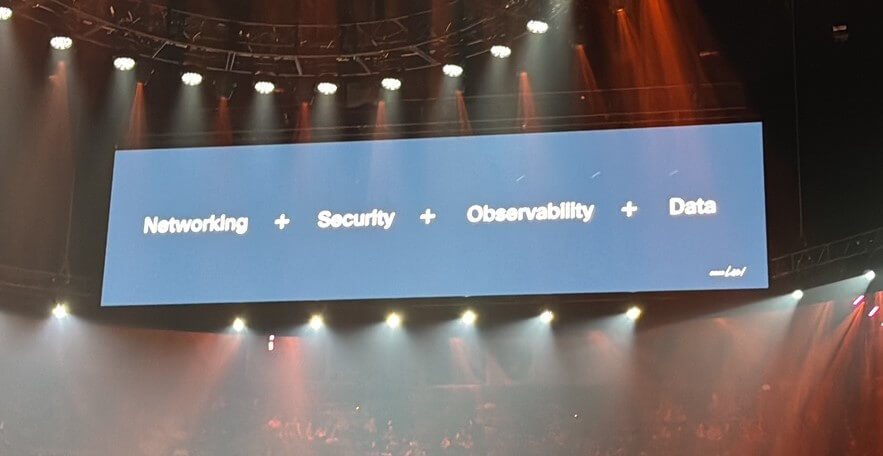This year’s Cisco Live was action-packed, between all the new production announcements and integration to special guests from Formula One and the NFL. Around 20,000 people attended the conference at the Mandalay Bay Resort in Las Vegas this year, with the show’s theme being “Go Beyond” (I will explain later why I felt that was appropriate). Still, the oft-repeated mantra was that of “connect and protect.” The program provided an excellent opportunity for customers to hear from Cisco executives and staff to gauge progress from last year, learn about and get trained on the new solutions, and understand Cisco’s vision for the future.
As one might imagine, with Cisco recently completing the Splunk acquisition, many in the crowd were eager to hear more about Cisco’s plans for the company beyond what had already been announced (Security and Splunk). And, of course, an industry event wouldn’t be complete this year if it didn’t talk about AI. Spoiler alert – Cisco talked about AI – a lot. Every tech show this spring season has focused heavily on AI, with conversations about supporting the back-end GPU environments for Generative AI and using AI/ML solutions to drive IT operational efficiencies, often called AIOps.
Cisco did not disappoint in any of these categories. In addition to those topics, Cisco highlighted that they were keeping up with the accelerated pace of change and innovation in IT. For example, Cisco CEO Chuck Robbins highlighted how new GPU tech is delivered every 12 months instead of 24-36 months. To that end, Cisco unveiled numerous solutions and integration announcements across all business units. However, what I found interesting was that many of these announcements went beyond a single business unit and demonstrated how Cisco could deliver enhanced value by integrating solutions across multiple Cisco business units and with ecosystem partners.
I will cover only some of the announcements as numerous press releases and news articles will recap those, but here are a few that were worthy of note.
- Networking – In the networking space, it was great to see the continued commitment to the Networking Cloud, announced last year, by adding both the Meraki and Catalyst SD-WAN solutions to the platform. They also introduced the concept of a Global Area Network (GAN) and the Thousand Eyes Digital Experience Assurance solution, which enables organizations to have visibility and control of both owned (on-prem) and unowned (internet) network environments. As enterprise IT, application, and AI environments continue to be more distributed, solutions like this will be necessary to ensure optimized performance and experiences.
- Security – The big news in the security space was Cisco Hypershield. While technically announced at RSA, Cisco allocated time in the keynotes to highlight the value of this solution in modern application environments and the ability to distribute security as closely as possible to the applications. Cisco also announced support for AMD-Pensando DPUs. Cisco also rolled out a new firewall and a universal AI assistant based on the security assistant (more on this later).
- Observability -So clearly, the big news is that Splunk is now part of Cisco, and much of the news here is related to the integrations that are taking place with existing Cisco tools like AppDynamics and the Full Stack Observability solutions, which I will cover below. Also, with .conf coming up next week, expect to see more announcements related to observability.
- Collaboration – This was highlighted as part of the day two keynotes, focusing on delivering enhanced customer experiences across office and remote locations. CEO Chuck Robbins believes organizations should make the office a magnet to draw employees back in, not an executive mandate. This mantra is realized in the Cisco NYC office, and it is worth the time to take a tour to see what is possible. (How to Make Your Office a Magnet to Attract Employees – theCUBEResearch). Webex will also get an AI assistant as part of the Universal AI assistant program to drive operational efficiency.
- Ecosystem – Throughout the conference, Cisco highlighted partnerships with numerous companies, including Nvidia, Microsoft, Lenovo, Vast Data, and others. We did not have an appearance by Jensen Huang of NVIDIA as he was at COMPUTEX in Taipei (while being halfway around the globe is a good excuse for not being there, Taylor did make it back in time to see Travis in the Superbowl…. Just sayin’ 😉 )
As I mentioned earlier, I found it interesting that many of Cisco’s announcements were “going beyond” a single business unit and that integrations between business units could potentially deliver significantly more value to customers. Here are some of the interesting integration announcements.
- Security and Splunk. This was announced at closing as the first point of integration. It made sense then and still makes sense now. Highly distributed environments have larger attack surfaces and face more sophisticated and advanced attacks. Leveraging the data collected and correlated by Splunk makes a lot of sense.
- Cisco’s AppDynamics (AppD) and Full Stack Observability (FSO) teams are now part of Splunk. To eliminate any internal competition between solutions, Cisco decisively made AppD and FSO part of Splunk. This enables them to work closely to drive their combined value into the observability platform and accelerate user innovation.
- Networking and Splunk. I was relieved to hear Jonathan Davidson mention that Thousand Eyes would also be integrating with Splunk. The Thousand Eyes solution extracts data across both the public internet and into home office devices and virtually all Cisco on-premises networking devices. This integration will ensure a more complete view of these distributed environments for Splunk.
- Security and Networking. Another example of cross-business unit integration, the security and networking teams highlighted further integration with Secure Access and SASE solutions, enabling firewalls in SD-WAN and SD-WAN in firewalls. The ability to have tighter integration between the network and security clouds will become increasingly important—even if in larger organizations, these are siloed teams. Tightly integrated network and security technologies are the future; it just might take a bit longer for an operations team’s culture to catch up.
Since there was so much discussion about AI, it deserves its own section. Here are some of the more notable AI announcements made this week.
- Cisco created a Global AI Investment Fund. Cisco has an active investment team focused on inorganic growth and investments; however, this is specifically focused on emerging AI technology. Cisco has dedicated one billion dollars to investing in companies to help drive innovation in this space and keep track of exciting advancements.
- Nexus HyperFabric. This announcement is focused on Cisco helping enterprises build out their own private GenAI GPU environments. Cisco will package up the compute (with GPUs), a high-performance ethernet network, and Vast Data solutions. The goal is to accelerate organizations’ time to value by leveraging a pre-validated and tested solution backed by Cisco and its partners.
- Splunk is foundational for AI. For AIOps or GenAI to work, one needs data—lots of data. Fortunately, Splunk is really good at collecting and managing data—lots of data! Cisco believes that by providing timely, relevant, and trusted data via Splunk, organizations will be able to accelerate model creation, training, and organization-specific fine-tuning or RAG.
- Unified AI Assistants. While this is also in the “Go Beyond” integration category, it is worth noting here. In a time when it is difficult to find highly skilled and trained IT professionals, AI assistants will enable operation teams and developers to use natural language processing to drive operational efficiency and higher productivity levels. AI assistants don’t negate the need for skilled professionals; right now, it is even more important to have highly trained resources interacting with AI tools to provide insights and feedback through a closed-loop system. I applaud Cisco for creating a universal AI assistant to ensure a consistent experience regardless of your technology area – networking, security, observability, or collaboration. This ensures that teams will have an inherent familiarity with the assistant as they converge.

Wrap up
Overall, Cisco Live demonstrated that it is moving faster and is innovating across business units to deliver value. The sheer volume of announcements was proof, and Cisco executives promised there would be even more announcements next year.
AI is getting much attention, and in one of the analyst breakout sessions, Cisco was able to articulate its strategy in a single slide. Clearly, Splunk will be foundational in providing timely, trusted, and relevant data to power its AI initiatives. Cisco is also investing in the AI ecosystem and highlighting the importance of moving forward in a transparent, responsible, and ethical manner. Its billion-dollar fund to invest in AI technology companies will only serve to drive more innovation. The Nexus HyperFabric ecosystem solution will help accelerate GenAI environments for on-premises deployments and provide choices for organizations.
It’s great to see the increased volume of announcements, and undoubtedly, there will be more next week at .conf. To determine the success of Cisco Live 2024, organizations will need to see how well these integrations are executed and the value received from them. I am looking forward to seeing the progress Cisco makes against its AI vision, numerous announcements, and its ability to “Go Beyond” its traditional business unit silos to deliver tightly integrated Cisco solutions.



